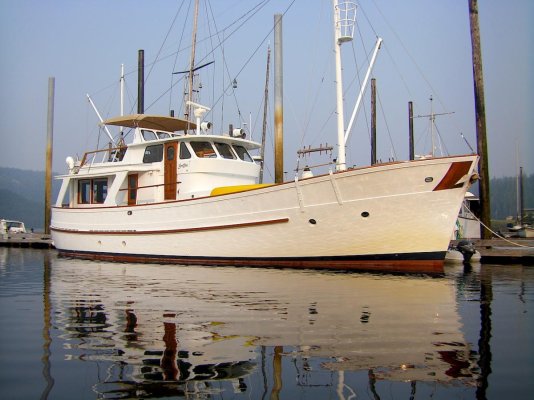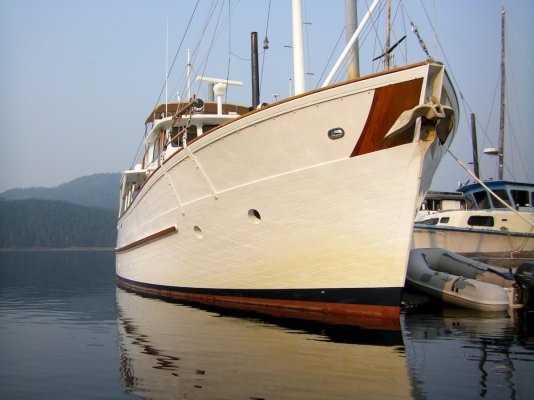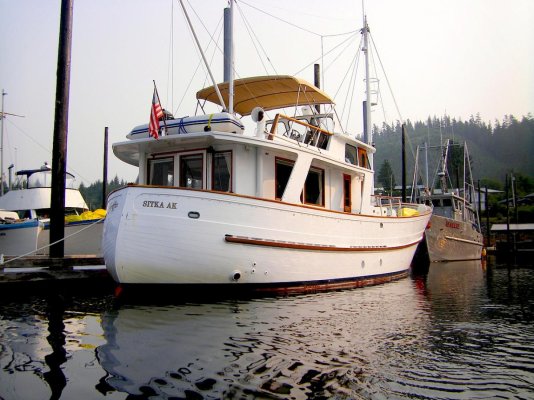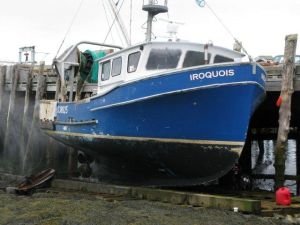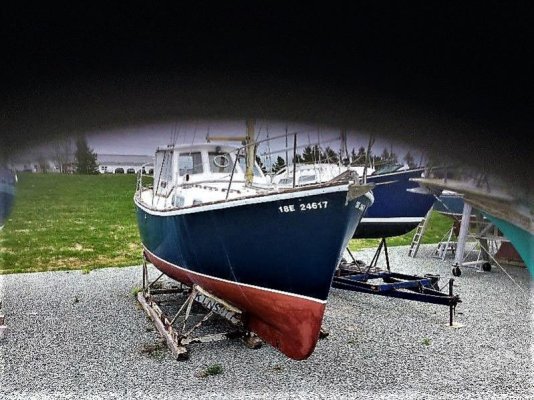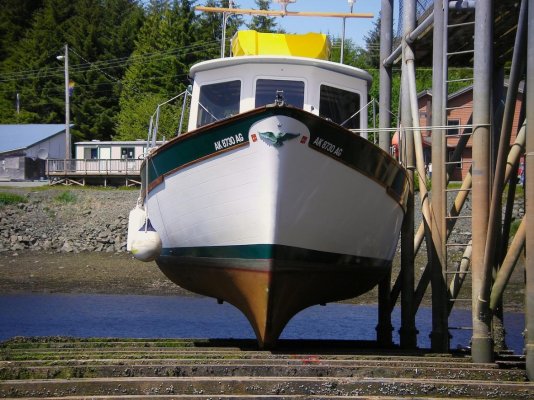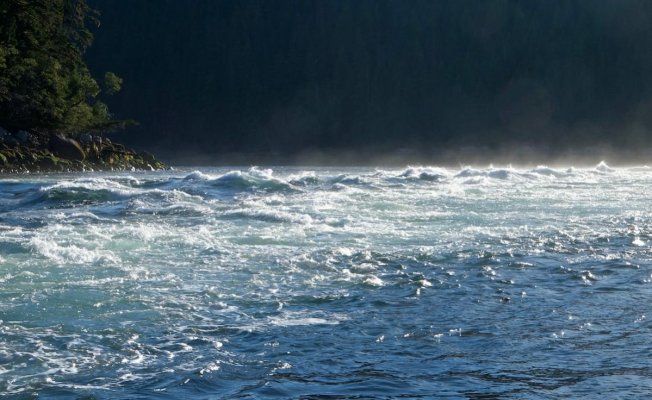You are using an out of date browser. It may not display this or other websites correctly.
You should upgrade or use an alternative browser.
You should upgrade or use an alternative browser.
Interesting boats
- Thread starter Steve
- Start date
The friendliest place on the web for anyone who enjoys boating.
If you have answers, please help by responding to the unanswered posts.
If you have answers, please help by responding to the unanswered posts.
Nomad Willy
Guru
It’s to reduce “squat” and extend the speed range of a FD boat.
OldDan1943
Guru
- Joined
- Oct 2, 2017
- Messages
- 10,658
- Location
- USA
- Vessel Name
- Kinja
- Vessel Make
- American Tug 34 #116 2008
reduce or prevent teeter-totter effect??
I really don't know.
I really don't know.
MurrayM
Guru
Never heard of this one before..."Puget Sound Motorsailer"...about the most trawler leaning motorsailer I've seen:
http://www.sailboatlistings.com/view/45783
http://www.sailboatlistings.com/view/45783
Never heard of this one before..."Puget Sound Motorsailer"...about the most trawler leaning motorsailer I've seen:
http://www.sailboatlistings.com/view/45783
Nice MS!
Northern Spy
Guru
- Joined
- Feb 5, 2012
- Messages
- 4,092
- Location
- Canada
- Vessel Name
- Northern Spy
- Vessel Make
- Nordic Tug 26
Never heard of this one before..."Puget Sound Motorsailer"...about the most trawler leaning motorsailer I've seen:
http://www.sailboatlistings.com/view/45783
We talked about her sister ship in the spring post 4119. She didn't have a mast. There were 8 built as I recall. Another one was for sale this summer. Really like the look of them. Except no place to land a salmon.
Last edited:
AlaskaProf
Guru
- Joined
- Jun 26, 2016
- Messages
- 2,302
- Location
- US of A
- Vessel Name
- boatless, ex: Seeadler
- Vessel Make
- RAWSON 41
Never heard of this one before..."Puget Sound Motorsailer"...about the most trawler leaning motorsailer I've seen:
http://www.sailboatlistings.com/view/45783
It's a "Comfort 38". There was one for sale in Anacortes this summer, and another in Kodiak. ...just checked, don't see either on the market now.
Last edited:
C lectric
Guru
As for the bustle shown look up a boat called Menorquin. Photos here:
https://www.google.ca/search?q=Meno...G32MKHam8BlAQsAQIPw&biw=1821&bih=849&dpr=0.75
ABout 20 years ago they were being pushed on the east coast . Never saw one but lots of photos and write ups.. That bustle was a modification to the original hulls to get more speed from their mostly displacement hulls for fishing and commercial use.
It apparently did work. From the articles it also improved seakeeping.
In the pleasure boat market that bustle got expanded, a lot.
Then an economic downturn occurred and I never heard of them again untill now.
The bustle for commercial was much smaller than the pleasure boat versions.
Looks like the bustle was not only Spanish.
https://www.google.ca/search?q=Meno...G32MKHam8BlAQsAQIPw&biw=1821&bih=849&dpr=0.75
ABout 20 years ago they were being pushed on the east coast . Never saw one but lots of photos and write ups.. That bustle was a modification to the original hulls to get more speed from their mostly displacement hulls for fishing and commercial use.
It apparently did work. From the articles it also improved seakeeping.
In the pleasure boat market that bustle got expanded, a lot.
Then an economic downturn occurred and I never heard of them again untill now.
The bustle for commercial was much smaller than the pleasure boat versions.
Looks like the bustle was not only Spanish.
As for the bustle shown look up a boat called Menorquin. Photos here:
https://www.google.ca/search?q=Meno...G32MKHam8BlAQsAQIPw&biw=1821&bih=849&dpr=0.75
ABout 20 years ago they were being pushed on the east coast . Never saw one but lots of photos and write ups.. That bustle was a modification to the original hulls to get more speed from their mostly displacement hulls for fishing and commercial use.
It apparently did work. From the articles it also improved seakeeping.
In the pleasure boat market that bustle got expanded, a lot.
Then an economic downturn occurred and I never heard of them again untill now.
The bustle for commercial was much smaller than the pleasure boat versions.
Looks like the bustle was not only Spanish.
I can only imagine what would happen in steep, close duration following sea waves.
It is kind of interesting how many different ways people modify the bottom contours of displacement hulls. Don't they like them in as is design??
Steve
Guru
Here is a Menorquin boat with the "appendage". I saw a couple years ago I believe it was at one of the Miami Boat Shows. These were offshoot of a Spanish fishing boat maybe to keep the nets out of the prop?https://images.search.yahoo.com/yhs...pg&w=3072&h=2304&t=1450091309000&action=click
OldDan1943
Guru
- Joined
- Oct 2, 2017
- Messages
- 10,658
- Location
- USA
- Vessel Name
- Kinja
- Vessel Make
- American Tug 34 #116 2008
Look like a glorified swim platform.
Nomad Willy
Guru
OldDan1943
Guru
- Joined
- Oct 2, 2017
- Messages
- 10,658
- Location
- USA
- Vessel Name
- Kinja
- Vessel Make
- American Tug 34 #116 2008
Griffin as seen in Throne Bay 12 years ago.
Small Cat engine.
That is one huge tide. Good thing it is a floating dock.
Is that tall black 'thingie' the exhaust?
Nomad Willy
Guru
That is one huge tide. Good thing it is a floating dock.
Is that tall black 'thingie' the exhaust?
It’s not a dock. It’s a float.
Tides are 23’ max.
The tall black thing is a piling. You’ll notice that the blak thing changes color in one of the pics. You had me going there for a sec. I was rowing around in my row boat taking these pics. Griffin has an aft engine (small yellow Cat) ... I went aboard and absolutely loved the boat.
Griffin has been for sale since I took these pics.
Here is my own boat on the tidal grid.
Attachments
Last edited:
Al
Guru
- Joined
- Apr 1, 2012
- Messages
- 2,206
- Location
- usa
- Vessel Name
- 'SLO'~BELLE
- Vessel Make
- 1978 Marben-27' Flybridge Trawler(extended to 30 feet) Pilothouse Pocket Cruiser[
I can't imagine 23' tides. That's just amazing.
Eric, on that tidal grid, do boats ever fall over? That seems like a really scary tie-up to this low-tide person.
Yep!!!
 The process is to tie the boat to the grid piling and as the tide falls, stand on the inboard side to assure list to the piling. If you want to see sad, one that was not tended as such.
The process is to tie the boat to the grid piling and as the tide falls, stand on the inboard side to assure list to the piling. If you want to see sad, one that was not tended as such. Nomad Willy
Guru
Dude,
I was always a bit nervous putting Willy on the grid. A lot of the time I had to walk down to the harbor in the dark of the night even while snowing to move the boat over to/on the grid. Had to pay $35 to city hall for using the grid. Every time I wished I had an inclinometer on the boat.
The first time I made a kinda big mistake. My 30’ Willard did not have a straight keel and I assumed it did when I positioned her over the grid. Well, she settled down OK but later as the tide fell I found that the keel was curved as in a slight amount of rocker. So she settled on two sopts along the keel. That was bad enough but uppon more scrutiny discovered that 90% of the weight was on one spot. About 14,000lbs was applied to one spot just about amidships. No damage came to pass but I was quite nervous.
After that I tied stout wood boards to the steel grid beams to spread the weight about equally on two places about 12’ apart. That was usually in the middle of the night but that beat doing the work at night by flashlight. Been there done that too. Tying on the boards made another trip down to the grid at low tide to tie the boards to the grid beams. So going on the grid turned out to be quite a bit of work and time.
Sure wish I had the grid option now. Now it’s 3-$400 bucks.
I was always a bit nervous putting Willy on the grid. A lot of the time I had to walk down to the harbor in the dark of the night even while snowing to move the boat over to/on the grid. Had to pay $35 to city hall for using the grid. Every time I wished I had an inclinometer on the boat.
The first time I made a kinda big mistake. My 30’ Willard did not have a straight keel and I assumed it did when I positioned her over the grid. Well, she settled down OK but later as the tide fell I found that the keel was curved as in a slight amount of rocker. So she settled on two sopts along the keel. That was bad enough but uppon more scrutiny discovered that 90% of the weight was on one spot. About 14,000lbs was applied to one spot just about amidships. No damage came to pass but I was quite nervous.
After that I tied stout wood boards to the steel grid beams to spread the weight about equally on two places about 12’ apart. That was usually in the middle of the night but that beat doing the work at night by flashlight. Been there done that too. Tying on the boards made another trip down to the grid at low tide to tie the boards to the grid beams. So going on the grid turned out to be quite a bit of work and time.
Sure wish I had the grid option now. Now it’s 3-$400 bucks.
Tidahapah
Guru
- Joined
- Oct 7, 2007
- Messages
- 1,859
- Location
- Australia
- Vessel Name
- Flora
- Vessel Make
- Timber southern cray boat
I reckon they could be the engine bearer bolt heads. I have four a side protruding from my ironbark bottom.
John, I would say you are absolutely right.
Engine bed frogs is the term used. The thru bolts for securing the engine beds to the frames.
Cheers
Benn
MurrayM
Guru
I can't imagine 23' tides. That's just amazing.
Yup, tidal currents have a pretty big impact, both positive (get a free boost if going with it, and the tides stir up nutrients which supports an amazing amount of Life) and negative (slows you down traveling against it, makes choosing anchoring locations interesting, and makes docking different every single time).
Here's a photo of Foch Lagoon Rapids at an average tide...have to get there on one over 20 feet to see how crazy it can get
Attachments
OldDan1943
Guru
- Joined
- Oct 2, 2017
- Messages
- 10,658
- Location
- USA
- Vessel Name
- Kinja
- Vessel Make
- American Tug 34 #116 2008
It’s not a dock. It’s a float.
Tides are 23’ max.
The tall black thing is a piling. You’ll notice that the blak thing changes color in one of the pics. You had me going there for a sec. I was rowing around in my row boat taking these pics. Griffin has an aft engine (small yellow Cat) ... I went aboard and absolutely loved the boat.
Griffin has been for sale since I took these pics.
Here is my own boat on the tidal grid.
Yea, now I see it, it is a piling.
There must be a reason for the Griffin being put on the market after you bought your boat. Maybe is was destiny.
With that tidal grid, you have no excuse for not doing a quick bottom cleaning and on a good day, a bottom paint and a zinc inspection and change if necessary.
Nice bow-on shot of your boat.
Last edited:
OldDan1943
Guru
- Joined
- Oct 2, 2017
- Messages
- 10,658
- Location
- USA
- Vessel Name
- Kinja
- Vessel Make
- American Tug 34 #116 2008
Yup, tidal currents have a pretty big impact, both positive (get a free boost if going with it, and the tides stir up nutrients which supports an amazing amount of Life) and negative (slows you down traveling against it, makes choosing anchoring locations interesting, and makes docking different every single time).
Here's a photo of Foch Lagoon Rapids at an average tide...have to get there on one over 20 feet to see how crazy it can get
I have seen movies showing people surfing the incoming tide.
Nomad Willy
Guru
Old Dan wrote;
“With that tidal grid, you have no excuse for not doing a quick bottom cleaning and on a good day, a bottom paint and a zinc inspection and change if necessary.”
Not that easy. Several things are tricky and much of it is time comsuming.
Watch the tide very closely to make sure you arrive over the grid while there’s some clearence below your keel. One dosn’t want to get caught contacting the grid before it’s time. But you don’t want to spend too much time “work’in the lines” either like an hour or so. When the tide has 15 to 19’ to go it needs to rise fast .. or decend fast.
I go in bow first to make it easier to get the bow line around the piling. Boat needs to be positioned well fore and aft so the grids are right for boat support, the shoe and rudder are not taking any load, the boat is such that the gunn’l contacts the right piling and perhaps that the stern isn’t out too far.
With the bow line around it’s piling give enough slack to pull the stern in and get that line around the piling. Adjust so I’m in position. Get the midships line around it’s piling. Check for slight list toward the pilings. I put padding between the piling and the gunn’l. It’s hard to keep the padding in place.
Then I “work the lines”. With the big tide that’s going to give me the working time below the boat will drop fairly fast and all of the above needs to be done well before any part of the keel touches the grids. Then I need to move between the lines adjusting them quickly so no one will get too tight. With the tide dropping fast and all three lines fairly tight when she settles I need to go from line to line constantly adjusting. Tight enough to hold the slight list and not too tight. On the short lines the quickly dropping tide can build up lots of tension fast. Could probably pull cleats out or “hang” a boat on the pilings or worse. So I don’t tie the lines too tight. Need a very small amount of, not really slack but loose enough that it won’t become REALLY tight when you get back to that line. And if you have any problems w any other line the other two will be getting tight fast. Tending all three I’ve got all my senses tuned to the moment the keel touches the grid .. rolling motion stops .. all boat motion. I make another check and adjustment and stop. Try to see the boat move. Then I watch like a hawk for a few more minutes.
Then I can crawl up the grid ladder. If it’s at night I go home and set the alarm. Don’t want to miss much of that hard earned working time below. Daytime and perhaps I have lunch and coffee at the little cafe-like place. It’s a post office, kinda store, kinda cafe and float plane terminal known as “the port”.
Afere I do my work w props, zincs or bottom paint I have a bit of slack time. But I need to get back on watch to be ready for the re-float. Positively don’t want to be late and find my boat .. whatever. So I usually take a book to read while I sit in the boat waiting for the moment when boat movement starts. So it can’t be a good book or I likely would get caught unawares. When it happens I untie quickly before a line gets too tight and back off the grid.
And Old Dan you can see I may have plenty of excuses not to be too eager to go back on the grid for a quick bottom paint and zinc check. It’s not as easy as putting gas in your car.
“With that tidal grid, you have no excuse for not doing a quick bottom cleaning and on a good day, a bottom paint and a zinc inspection and change if necessary.”
Not that easy. Several things are tricky and much of it is time comsuming.
Watch the tide very closely to make sure you arrive over the grid while there’s some clearence below your keel. One dosn’t want to get caught contacting the grid before it’s time. But you don’t want to spend too much time “work’in the lines” either like an hour or so. When the tide has 15 to 19’ to go it needs to rise fast .. or decend fast.
I go in bow first to make it easier to get the bow line around the piling. Boat needs to be positioned well fore and aft so the grids are right for boat support, the shoe and rudder are not taking any load, the boat is such that the gunn’l contacts the right piling and perhaps that the stern isn’t out too far.
With the bow line around it’s piling give enough slack to pull the stern in and get that line around the piling. Adjust so I’m in position. Get the midships line around it’s piling. Check for slight list toward the pilings. I put padding between the piling and the gunn’l. It’s hard to keep the padding in place.
Then I “work the lines”. With the big tide that’s going to give me the working time below the boat will drop fairly fast and all of the above needs to be done well before any part of the keel touches the grids. Then I need to move between the lines adjusting them quickly so no one will get too tight. With the tide dropping fast and all three lines fairly tight when she settles I need to go from line to line constantly adjusting. Tight enough to hold the slight list and not too tight. On the short lines the quickly dropping tide can build up lots of tension fast. Could probably pull cleats out or “hang” a boat on the pilings or worse. So I don’t tie the lines too tight. Need a very small amount of, not really slack but loose enough that it won’t become REALLY tight when you get back to that line. And if you have any problems w any other line the other two will be getting tight fast. Tending all three I’ve got all my senses tuned to the moment the keel touches the grid .. rolling motion stops .. all boat motion. I make another check and adjustment and stop. Try to see the boat move. Then I watch like a hawk for a few more minutes.
Then I can crawl up the grid ladder. If it’s at night I go home and set the alarm. Don’t want to miss much of that hard earned working time below. Daytime and perhaps I have lunch and coffee at the little cafe-like place. It’s a post office, kinda store, kinda cafe and float plane terminal known as “the port”.
Afere I do my work w props, zincs or bottom paint I have a bit of slack time. But I need to get back on watch to be ready for the re-float. Positively don’t want to be late and find my boat .. whatever. So I usually take a book to read while I sit in the boat waiting for the moment when boat movement starts. So it can’t be a good book or I likely would get caught unawares. When it happens I untie quickly before a line gets too tight and back off the grid.
And Old Dan you can see I may have plenty of excuses not to be too eager to go back on the grid for a quick bottom paint and zinc check. It’s not as easy as putting gas in your car.
Last edited:
OldDan1943
Guru
- Joined
- Oct 2, 2017
- Messages
- 10,658
- Location
- USA
- Vessel Name
- Kinja
- Vessel Make
- American Tug 34 #116 2008
Not that easy. Several things are tricky and much of it is time comsuming.
And Old Dan you can see I may have plenty of excuses not to be too eager to go back on the grid for a quick bottom paint and zinc check. It’s not as easy as putting gas in your car.
Yup, not easy but, if you have the guts and knowledge, you can save a few buck. Maybe you should become a professional for other boat owners???
Years ago, I was told of some concrete cradles that would "appear" once the tide went out. The key is to get the boat perfectly centered before the tide goes out and the work done before the tide comes in. Misjudge the tide and you end up swimming next to your boat. None of that, "just 5 more mins and I will be finished."
What's life without some excitement.
Hey NW and OD... I give you guys lots o' credit!!
I've worked on bottom of lobster boats in Maine, laying em over on small-rock shores, utilizing tide factors and side stilts so the lean did not let gunnels go awash when tide came back in. Also have rebuilt piling docks' girders [etc] using tidal times in Atlantic and Pacific.
Tidal water level changes fast! Don't know if I'd like to chance some of the danger what I see in NW''s photo 4547 and in post 4555
BTW NW - Great photo in 4547!
I've worked on bottom of lobster boats in Maine, laying em over on small-rock shores, utilizing tide factors and side stilts so the lean did not let gunnels go awash when tide came back in. Also have rebuilt piling docks' girders [etc] using tidal times in Atlantic and Pacific.
Tidal water level changes fast! Don't know if I'd like to chance some of the danger what I see in NW''s photo 4547 and in post 4555
BTW NW - Great photo in 4547!
Sailor of Fortune
Guru
View attachment 69749
[A
TTACH]69750[/ATTACH] Iroquois is my old commercial trawler, it's a Cape Dory 38. The other one (sorry about the bad picture) is a Colvic Watson I found in Canada and just bought for a family cruiser.
Was Iroquois the old Original "Dory one"?
Last edited:
RT Firefly
Enigma

Conrad
Guru
- Joined
- Oct 19, 2007
- Messages
- 1,972
- Location
- Canada
- Vessel Name
- Blue Sky
- Vessel Make
- Nordic Tugs 42 Hull #001
Bonnie Belle; a classic beauty we passed just outside of Klemtu, BC
That appears to be the Bonnie Belle that has been berthed here in Campbell River for ages. We went on a daycharter on her years ago. As I recall, she was built in 1953 and was never fished commercially but rather used as a pleasure and charter vessel.
I don't recall the builder unfortunately.
Similar threads
- Replies
- 3
- Views
- 2K
- Replies
- 28
- Views
- 1K

